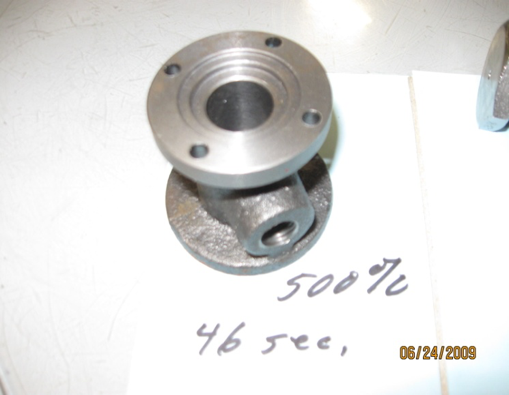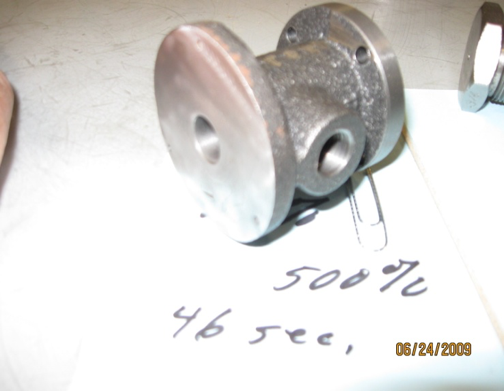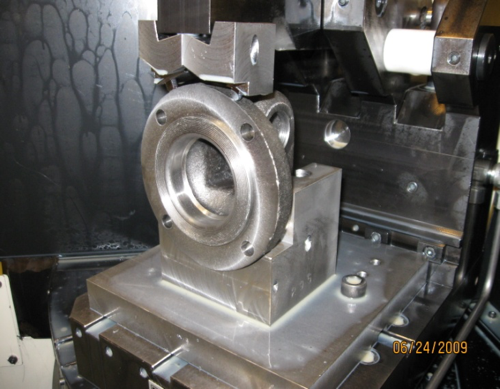When you have to choose which technology to adopt in your company, and avoid mistaken investment, the doubts begin to take control and it is like you are not able to reason with good sense.
The typical question with which many people go to crisis is:
DO I HAVE TO PURCHASE THE MULTICENTER
OR A BATTERY OF MACHINING CENTERS?
As in all situations there are the pros and the cons, in fact the exact answer is: “IT DEPENDS…”
If you were waiting for a clean answer for the MULTICENTER it is not this way. Even if I am a CONVINCED FAN of this technology, honestly speaking it is not always the best and I will explain to you why:
Let’s start by analyzing why the MACHINING CENTER can result in more convenience.
The first thing you have to analyze is the annual quantity to produce in order to understand if a machining center can be enough for you: if yes, you already found your ideal machine and the game is done.
On the contrary, how many one-spindle machines do you need to satisfy your production?
Here begins the first surprises between MULTICENTER and machining centers.
The most produced MULTICENTER is model 3SPINDLES: this machine is produced in series, therefore it is STANDARD for over 10 years and today it is in its third version, renewed with technical improvements but always preserving its basic concept.
The first surprise is that the MULTICENTER 3SINDLES produces more than 3 machining centers with pallet change, and more than 4 machining centers without pallet change. In fact, here are the proportions:
MULTICENTER 3SPINDLES = 3.4 Horizontal machining centers with pallet change
MULTICENTER 3SPINDLES = 4.2 Vertical machining centers without pallet change
Let’s start from the first situation: why would the MULTICENTER produce more than 3 machining centers with pallet change?
The answer is quite simple, by the same machine, meaning machines ISO40, the performances of tool change (1,4sec) and particularly comparing the pallet change (only 2,2sec) in comparison to machining centers of the same dimension, the MULTICENTER has less dead time and therefore in one year of production it results to be more productive than 3 machining centers.
If we go to compare the second solution, that is machining centers without pallet change, here the replacement is even more for the MULTICENTER, because the part change enters the part cycle time, while on the MULTICENTER the part change does not affect cycle time having a station dedicated to this operation.
THE MULTICENTER HAS INDEED THE NUMBERS IN ITS FAVOR?
The numbers in its favor in terms of general performance, meaning the part cost, derives from examining of the TCO (Total Cost of Ownership) that means to evaluate the total cost of possession of the machinery in terms of:
- NECESSARY TOTAL ENERGY TO PRODUCE YOUR QUANTITIES
- OCCUPIED ROOM IN THE COMPANY
- NUMBER OF THE NECESSARY PERSONNEL TO PRODUCE
- NUMBER OF THE NECESSARY PERSONNEL FOR THE PRODUCTION CHANGE
- COSTS OF THE FIXTURES
- QUANTITY OF NECESSARY FIXTURES
- MAINTENANCE COSTS FOR FIXTURES
- COSTS OF THE AUTOMATION
- PRODUCTION CHANGE SPEED
- PRODUCTION CYCLE TIME
These are the first 10 points with which you have to deal with, considering a comparison among the MULTICENTER 3SPINDLES ISO40 and Machining centers, always ISO40.
Because some years ago it also happened to me that the MULTICENTER has been compared on the paper with machining centers of lower category, or better, of lower dimension, that is with machining centers ISO30 where the customer has not kept in mind, for example, that the data relating the workmanship must have lowered from 30% to 40% in consideration of the light structure of these machines and the very reduced spindle power, proper for that typology of machine.
In general all machining centers have an OPEN structure and not CLOSE as the MULTICENTER, which allows a rigidity of the machine equivalent to a machining center ISO50.
Here is a interesting real case where the MULTICENTER 3SPINDLES have replaced a machining center ISO50.
THE MULTICENTER ISO40 HAS REPLACED A MACHINING CENTER ISO50
THANKS TO ITS CLOSED STRUCTURE!
HERE IS THE TESTIMONY OF KIMRAY…
Kimray is a private stock company that produces a range of pumps and control valves for the oil industry. These components vary from 1″ to more than 36″, and are made of both steel and iron. The overall volume of components produced by Kimray has almost doubled in recent years. A large part of their production increases concerns components belonging to the smaller range, with precision finishing requirements. This is the product range on which Kimray has focused its efforts in order to increase their processing capacity.
In Kimray’s case, the wide range of offers, the ever increasing volumes and the “just in time” company philosophy required a processing cell with high PRODUCTIVITY and HIGH FLEXIBILITY, as well as great accuracy in complying with their demanding quality requirements.
THE INTEREST IN THE MULTICENTER
After a complete and careful survey of the machine tools available on the market, Kimray found the MULTICENTER to be particularly interesting. The MULTICENTER is a machine equipped with three four-axis processing modules, each one with excellent tool storage capacity and a central rotating table.
In addition to being a very fast machine (typically comparable to the yield of four horizontal machining centers), the Multicenter is designed to process heavy iron materials.
One of the unique characteristics which attracted Kimray’s attention is the ability to quickly re-equip the machine for small batches, avoiding stock and quickly producing the market requests (TIME TO MARKET) i.e. the time from the purchase order to the time when goods is shipped without making stock.
Thanks to this method, with annual lots of 500, 1.000, 2.500 and 5.000 pieces, Kimray can take advantage of the low costs offered by this machine, without adding long set-up times and costs for the tooling.
The fact that the MULTICENTER controlled through FANUC/SIEMENS is a standard product for PORTA is highly appreciated by Kimray.
PRODUCTION RESULTS
Seven months after the machine was installed, Kimray discovered that, thanks to the MULTICENTER, it is able to produce much larger quantities compared to those estimated at the time of purchase and also compared to the projections that justified buying the MULTICENTER.
Using the universal tool concept, the cycle time turned out to be up to eight times faster with respect to the cycle time obtained through traditional machining centers.
At the same time, the set-up is simple and fast. The component change times are limited; even the initial machine set-up for a new component, including complex ones, is carried out faster.
THIS MACHINE IS ABLE TO PRODUCE AT RATES WHICH ARE MUCH FASTER COMPARED TO COMMON MACHINING CENTERS.
Indeed, this high-efficiency machine tool has allowed Kimray to do work internally that was previously outsourced internally, thus achieving better process control and also managing to handle smaller lots in favour of reduced stock on hand.
Therefore, the MULTICENTER has satisfied and exceeded Kimray’s expectations, and has become an important piece of equipment for the company in terms of continuing to offer high-quality and competitive products from the price standpoint.
A REAL ACCOUNT
Cast iron thermostat lid in just 46 seconds.

Cast iron thermostat cover – before it took 414 seconds – now just 46 seconds:

Cover made of malleable cast iron – before it took 330 seconds – now just 72 seconds.

AS YOU HAVE SEEN THE MULTICENTER IS VERY RIGID SO THAT TO GET UNEXPECTED CUTTING DATA AND TOOL LIFE!
Now, let’s try to imagine a comparison between MULTICENTER ISO40 and machining centers ISO30…
As we said, the cutting data by light machines ISO30 in the reality must have lowered from 30% to 40% in less.
The vibrations are always around the corner, reducing the tool life and the life of the machine tool.
Even if the tendency of the today’s society is the disposability, the MULTICENTER has been projected and built for lasting a long time, a machine life that arrives without problems to 30 years, while the ISO30 machines in the commerce hardly reach the 10 years of life, 1/3 less.
WHY NOT TO CHOOSE THE MULTICENTER
As we said before, the MULTICENTER is not machine tool for all the seasons, it has a well precise application and market range that is widening more and more, but that however cannot replace certain ranges.
Here is a list of the why the MULTICENTER does not fit to your case:
- IF A MACHINING CENTER IS ENOUGH TO PRODUCE YOUR QUANTITIES
- IF YOU MAKE A FEW PART CHANGES AND YOU DEDICATE THE MACHINE
- IF YOU WORK FOR YOUR STOCK AND NOT “JUST IN TIME”
- IF YOUR COMPONENTS OVERCOME A CUBE OF 250MM
- IF YOU HAVE A SHORT-TERM PROJECT (12/24 MONTHS) AND THEN YOU DO NOT NEED THE MACHINE ANYMORE
- IF YOU HAVE A FEW CODES TO PRODUCE, THEREFORE FEW FIXTURES
- IF THE OCCUPIED SPACE IS NOT A PROBLEM
If, on the contrary, you analyse the TCO, (Total Cost of Ownership), i.e. the total cost of exercise (investment, energy, maintenance, occupied area, manpower, etc.) that then determines the part cost to certain conditions as: quantity to be produced in small/medium batches without the use of the stock and the datum of TIME TO MARKET (necessary time to produce the requested pieces) then I recommend you to analyse in the detail the MULTICENTER.
As always I am at your disposal to help you to apply this system of FLEXIBLE PRODUCTION inside your company.
If you want to understand more, a convenient way is to get you my latest book “MACHINING CENTERS: TOO MUCH FLEXIBILITY KILLS YOUR PRODUCTIVITY!” you can request at the following link:
www.maurizioporta.com
I REMIND YOU THAT…
IT IS NOT THE STRONGEST OF THE SPECIES THAT SURVIVES BUT THE MOST ADAPTABLE!
Maurizio Porta
Expert in Flexible Production

 Ita
Ita Deu
Deu

